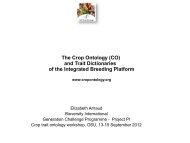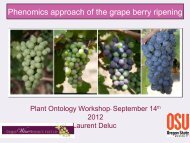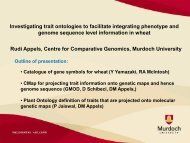Leaf Development - Plant Ontology Wiki
Leaf Development - Plant Ontology Wiki
Leaf Development - Plant Ontology Wiki
You also want an ePaper? Increase the reach of your titles
YUMPU automatically turns print PDFs into web optimized ePapers that Google loves.
<strong>Leaf</strong> <strong>Development</strong><br />
• Several meristems are involved in the<br />
development and growth of the leaves.<br />
• They are functioning either simultaneously<br />
or sequentially<br />
• These are the apical, adaxial, marginal,<br />
plate and intercalary meristems.
• The variation in leaf form is directly<br />
related to the relative activity and<br />
duration of the activity of these<br />
meristems<br />
– <strong>Plant</strong>s with heteroblastic development: the<br />
form of the leaf often changes in a single<br />
plant during its ontogeny.<br />
– <strong>Plant</strong>s with homoblastic development: leaf<br />
shape remains uniform.
M<br />
E<br />
R<br />
I<br />
S<br />
T<br />
E<br />
M<br />
S
Dicot leaf: 3 phases<br />
1. LEAF (PRIMORDIUM) INITIATION: initial cell division<br />
and cell growth<br />
2. PRIMARY MORPHOGENESIS: formation of primordial<br />
leaf axis or phyllopodium (dorsiventral symmetry;<br />
petiole and midrib)<br />
• While increasing in thickness, leaf lamina starts to form<br />
outgrowths resulting from cytokinesis in apical and marginal<br />
meristems (or marginal blastozones)<br />
• Continue activity of these meristems è lateral expansion of<br />
the lamina, each half extends upward on either side.<br />
• Compound leaves: marginal meristems become subdivided,<br />
each subdivision (leaflet) has its own phyllopodium and apical<br />
and marginal meristems.<br />
• With continuing cell division and cell expansion è entire leaf<br />
primordium curves upward.<br />
• Leaves with petiole (basal meristem)
• 3- EXPANSION & SECONDARY<br />
MORPHOGENESIS<br />
– Longest period in leaf development<br />
– <strong>Leaf</strong> continue to grow and differentiateè<br />
increase in area and volume (95% of the cells)<br />
– Marginal meristems : 2 layers, short life. Outer<br />
layer: epidermis<br />
– Rest of growthè intercalary and diffuse<br />
meristematic activity: parenchyma<br />
» Mesophyll and provascular tissue<br />
» <strong>Leaf</strong> margin is developed<br />
» Basic form: isometric growth<br />
» Different morphologies: allometric growth
C. Expansion & Secondary<br />
morphogenesis<br />
From dengler and Tsukaya- 2001. Int. J. Pl. Sci. 162: 459-464
This is a vegetative<br />
shoot apical meristem<br />
which consists of a<br />
small group of dividing<br />
cells, they give rise to<br />
leaf primordia in very<br />
regular and predictable<br />
temporal and spatial<br />
patterns.<br />
P1-P6 are existing<br />
primordia with P1 being<br />
the youngest. I1 and I2<br />
are the next primordia to<br />
be formed.
SHOOT MERISTEM (SM)<br />
• Maintains pool of undifferentiated cells<br />
• Directs undifferentiated cells toward organ<br />
formation and differentiation<br />
lp - leaf primordium; st - stipule primordium
REGIONS OF THE<br />
VEGETATIVE SHOOT MERISTEM<br />
• CZ - Central zone : Center of shoot<br />
meristem; low rates of cell division; cells<br />
remain undifferentiated<br />
• PZ - Peripheral zone: Surrounds the CZ;<br />
rapid rates of cell division; cells can<br />
differentiate<br />
• OZ - Organ zone: Site at which organ<br />
primordia (e.g.. leaf, flower) become<br />
distinct.<br />
• RM - Rib meristem: Gives rise to vascular<br />
and interior stem structures
• (A) The CZ consists of undifferentiated<br />
cells, which are characterized as being<br />
small, and primarily consist of cytoplasm,<br />
with only small vacuoles. More importantly,<br />
undifferentiated cells retain the ability to<br />
initiate any organ type.<br />
• (B) As the SM grows, cells from the CZ are<br />
"left behind" to form the PZ. It is thought<br />
that positional information in the PZ<br />
triggers differentiation into primordia.<br />
Once differentiation has begin, cell fate is<br />
determined. In other words, cells in the PZ<br />
might only be able to differentiate into leaf<br />
cells.<br />
• (C) As cell division continues, the older PZ<br />
cells begin to develop into discrete<br />
primordia (eg. leaf primordia), and are now<br />
referred to as OZ cells.<br />
cz: central zone<br />
pz: peripheral zone<br />
rm: rib meristem<br />
sm: shoot meristem
EXAMPLE<br />
cz: central zone<br />
pz: peripheral zone<br />
rm: rib meristem<br />
sm: shoot meristem
• The first structural sign that a leaf primordium is<br />
developing is the periclinal division of the cells<br />
on the apical flank of the shoot.<br />
• In dicots it occurs usually in the second and<br />
third layer of cell.<br />
• In some monocots the periclinal divisions may<br />
occur in the surface of the tunica.<br />
• REMEMBER: first layer normally originates<br />
epidermis! by anticlinal division.<br />
• The initial periclinal division is followed by<br />
several more resulting in the elevation of the leaf<br />
primodium above the surface of the apical<br />
meristem.
1- Apical meristem<br />
2- Anticlinal divisions (with the division plane at right angles to the<br />
surface; the division in parallel to the surface) in the cell layers<br />
under the epidermal layer (red in 2). After the first divisions also<br />
periclinal (at right angles to the surface) divisions occur the<br />
epidermis as well as in the layers underneath (blue in 2).<br />
3- The result is a small bulge (3) that will further develop into a leaf.<br />
From this point on, leaf growth differs between monocots and<br />
dicots.
<strong>Leaf</strong> initiation in Coleus
1- The initially formed bulge further elongates by mitotic cell<br />
divisions throughout the bulge (1-5).<br />
2- Next, at the top of the extended bulge, cells start to divide a single<br />
plane causing the bulge to broaden (6).<br />
3- Depending on the species, division activity may decrease or even<br />
cease completely (7-9). Thus, the typical irregularly shaped leaf<br />
blade of dicots is formed.<br />
4- The lower part of the extended bulge will develop into the leaf stalk<br />
or petiole (9).
• Axillary bud primordia are not formed until the<br />
leaf primordium is in its second or third<br />
plastochrone<br />
• In leaf with stipules, small outgrowth are<br />
formed on either side of the primordium base.<br />
• Palmately compound leaves the leaflet<br />
primordia also become evident on the third or<br />
fourth plastochrone<br />
• In pinnate leaves the pinnae develop from<br />
regions of the marginal meristem and their<br />
inception is usually delayed until a later<br />
plastochrone.
What happens with grasses?<br />
• In species with sheathing leaves the<br />
divisions spread laterally from the original<br />
localized site on the apical meristem è<br />
crescent-shaped leaf primordium without<br />
dorsiventral symmetry development.<br />
• The primordium growth vertically and the<br />
division also spread further around the<br />
apex.
Marginal growth<br />
• When the young dorsiventral leaf primordium<br />
reaches certain heights, small bulges appear<br />
laterally on either side = these are the<br />
marginal meristems.<br />
• Marginal meristems will determine the number<br />
of layer of the mesophyll cells in the lamina
Xanthium (Compositae)<br />
1- <strong>Leaf</strong> primordium ~ 0.22 mm at initiation of marginal<br />
growth<br />
2- Marginal meristems are active for 23 days<br />
3- 6 layers are established in the leaf
• Palisade tissue differentiates from the<br />
adaxial layer of mesophyll form by the<br />
marginal meristem<br />
• Spongy mesophyll from the abaxial<br />
layer of the marginal meristem
• Palisade tissue<br />
differentiates from the<br />
adaxial layer of<br />
mesophyll form by the<br />
marginal meristem<br />
• Spongy mesophyll from<br />
the abaxial layer of the<br />
marginal meristem<br />
SYRINGA (Oleaceae)
AT THE END…
VENATION PATTERNS<br />
Dicot: initiated by acropetal differentiation of a<br />
central provascular strand at the phyllopodium,<br />
as the lamina expands more veins are added in<br />
a hierarchical model (2 nd , 3 rd , 4 th , etc.). Higher<br />
order veins developed from the apical area<br />
(basipetally)<br />
Monocot: initiated by acropetal and basipetal<br />
differentiation. Higher order veins developed<br />
from the apical area (basipetally)
Vascular patterning<br />
• (a) In the dicot Arabidopsis, at least<br />
four size classes of longitudinal<br />
veins can be distinguished: (1)<br />
primary, (2) secondary, (3) tertiary,<br />
and (4) quaternary.<br />
• (b) In the monocot maize, a midvein<br />
(MV) and at least three size classes<br />
of longitudinal veins are present.<br />
Small commissural veins<br />
interconnect longitudinal veins.<br />
• (c–f) Transectional vascular<br />
patterns, illustrating variation in the<br />
arrangement of xylem (X) and<br />
phloem (P) tissues: (c) collateral<br />
pattern, (d) bicollateral pattern, (e)<br />
amphivasal pattern, and (f)<br />
amphicribral pattern.<br />
From Dengler and Kang 2001- Curr. Opin. <strong>Plant</strong> Biol. 4: 50- 56
SENESCENCE<br />
AND<br />
ABSCISSION<br />
(PROMISE: this is the last part)
• Independently of it development and<br />
shape, the leaf ultimately undergoes<br />
SENESCENCE and ABSCISEè falling<br />
from the plant.<br />
• Deciduous species: every year<br />
• Evergreen species: individual leaves<br />
abscise after one or more years of<br />
growth and development, but all the<br />
leaves do NOT fall at the same time.
• The activity of the leaves and other<br />
determinate organs of the plants is<br />
regulated by changes within them and by<br />
interaction with other parts of the plant<br />
• <strong>Leaf</strong> senescence is usually characterized<br />
by a yellowing of the tissues and by<br />
various biochemical changes.<br />
• During the whole process different<br />
patterns of metabolism may occur.<br />
• Structurally, the most important changes<br />
occur at the time of abscission
• <strong>Leaf</strong> abscission follows senescence or<br />
injury.<br />
• Abscission is regulated by several<br />
hormones and inhibitors.<br />
So what is abscission? …
ABSCISSION IS…<br />
Basically, it is a process that involves the<br />
separation of the leaf from the stem or<br />
basal region of the petiole by separation<br />
or lysis of the cells, and the subsequent<br />
formation of a suberized protective layer<br />
beneath the exposed surface
EXTERNALLY<br />
• An abscission zone in present at the base of<br />
the petiole<br />
• It is easily recognized by its pale or dark<br />
color<br />
• Sometimes it is constricted
One example: Phaseolus<br />
1- Abscission zone: increase of tyloses<br />
in the tracheary elements è may<br />
causes water stress<br />
2- Dissolution of callose in the sieve<br />
elementsè mobilization of materials to<br />
proximal tissues<br />
1 + 2: localized cellular<br />
senescence in the abscission zone
It may occur by:<br />
SEPARATION<br />
– Dissolution of middle lamella<br />
– Dissolution of middle lamella and primary wall<br />
– Mechanical breakage involving non-living<br />
elements<br />
è<br />
Changes into cell wall and in the enzymes<br />
which dissolve pectins, hemicellulose,<br />
cellulose, etc.
• In plants there several hormones that<br />
promote and inhibit plant growth<br />
– Growth promoters: auxins, gibberellins,<br />
cytokinins.<br />
– Growth inhibitors are ethylene and abscisic<br />
acid.<br />
– Hormone levels depend on the day length<br />
(photoperiod) along with the temperatures<br />
• Spring's lengthening days and warming<br />
temperatures cause trees to produce lots of<br />
growth-promoting hormones<br />
• Fall's shortening days and cooling temperatures<br />
produce growth-inhibiting hormones.
• Prior leaf abscission<br />
– Auxin decrease in the leaf and the abscission<br />
zone<br />
– As leaf become old, there are changes in the<br />
efficiency and direction of the auxin transport<br />
in the petiole<br />
– Now, the ABA (abscisic acid) and ethylene<br />
becomes involveè accelerating the<br />
abscission time
Abscission process…new version<br />
based on Arabidopsis<br />
A- Recognition of an ontogeny of the abscission<br />
B- Competence to respond to abscission signals<br />
C- Activation of the abscission process<br />
D- Recognize the trans-differentiation of a protective layer as the last<br />
basic step in the abscission-signaling pathway.





